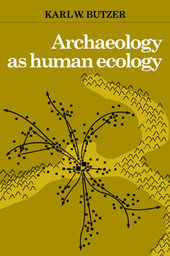
|
Archaeology as Human Ecology: Method and Theory for a Contextual Approach
Paperback / softback
Main Details
| Title |
Archaeology as Human Ecology: Method and Theory for a Contextual Approach
|
| Authors and Contributors |
By (author) Karl W. Butzer
|
| Physical Properties |
| Format:Paperback / softback | | Pages:380 | | Dimensions(mm): Height 229,Width 150 |
|
| Category/Genre | Archaeology |
|---|
| ISBN/Barcode |
9780521288774
|
| Classifications | Dewey:930.1 |
|---|
| Audience | | Tertiary Education (US: College) | |
|---|
| Illustrations |
Worked examples or Exercises
|
|
Publishing Details |
| Publisher |
Cambridge University Press
|
| Imprint |
Cambridge University Press
|
| Publication Date |
31 May 1982 |
| Publication Country |
United Kingdom
|
Description
Archaeology as Human Ecology is a new introduction to concepts and methods in archaeology. It deals not with artifacts, but with sites, settlements, and subsistence. Karl W. Butzer's goal is to interpret the ecosystem of which an archaeologicial site or site network was part. Components of this study include geo-archaeology, archaeobotany, zoo-archaeology, and archaeometry. These methods are then used in examining interactions between human communities and their biophysical environment: the impact of settlement on site formation and the effects of subsistence activities on plants, animals, soils, and overall landscape modification. Finally, the methods and theoretical approach, are applied to examine the processes of cultural change and continuity. The approach of Archaeology as Human Ecology goes far beyond traditional environmental archaeology, which is concerned with simple reconstruction. It provides a clear, systemic approach that immediately allows an assessment of interactions. For the first time, it attempts to develop a comprehensive spatial archaeology - one that is far more than derivative spatial analysis.
Reviews'... the culmination of a quarter of a century of critical enquiry in the broad borderlands between geography and archaeology. Karl Butzer in this book has shown his pre-eminence in both disciplines.' Geographical Magazine
|